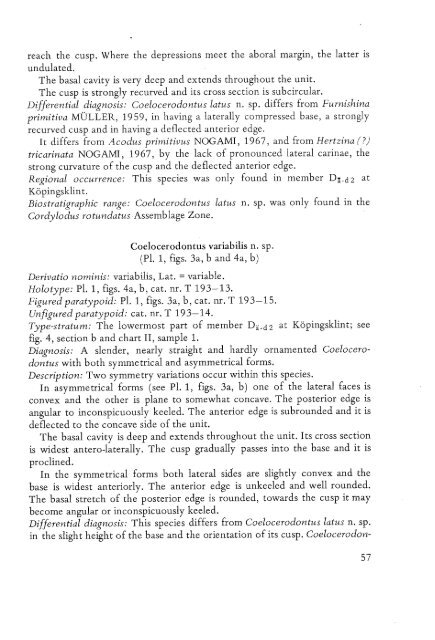UTRECHT MICROPALEONTOLOGICAL BUllETINS
UTRECHT MICROPALEONTOLOGICAL BUllETINS
UTRECHT MICROPALEONTOLOGICAL BUllETINS
Create successful ePaper yourself
Turn your PDF publications into a flip-book with our unique Google optimized e-Paper software.
each the cusp. Where the depressions meet the aboral margin, the latter is<br />
undulated.<br />
The basal cavity is very deep and extends throughout the unit.<br />
The cusp is strongly recurved and its cross section is subcircular.<br />
Differential diagnosis: Coelocerodontus latus n. sp. differs from Furnishina<br />
primitiva MOLLER, 1959, in having a laterally compressed base, a strongly<br />
recurved cusp and in having a deflected anterior edge.<br />
It differs from Acodus primitivus NOGAMI, 1967, and from Hertzina (I)<br />
tricarinata NOGAMI, 1967, by the lack of pronounced lateral carinae, the<br />
strong curvature of the cusp and the deflected anterior edge.<br />
Regional occurrence: This species was only found in member Da-d 2 at<br />
Kopingsklint.<br />
Biostratigraphic range: Coelocerodontus latus n. sp. was only found in the<br />
Cordylodus rotundatusAssemblage Zone.<br />
Coelocerodontus variabilis n. sp.<br />
(PI. 1, figs. 3a, band 4a, b)<br />
Derivatio nominis: variabilis, Lat. = variable.<br />
Holotype: PI. 1, figs. 4a, b, cat. or. T 193-13.<br />
Figured paratypoid: PI. 1, figs. 3a, b, cat. or. T 193-15.<br />
Unfigured paratypoid: cat. or. T 193-14.<br />
Type-stratum: The lowermost part of member Da-d 2 at Kopingsklint; see<br />
fig. 4, section b and chart II, sample l.<br />
Diagnosis: A slender, nearly straight and hardly ornamented Coelocerodontus<br />
with both symmetrical and asymmetrical forms.<br />
Description: Two symmetry variations occur within this species.<br />
In asymmetrical forms (see PI. 1, figs. 3a, b) one of the lateral faces is<br />
convex and the other is plane to somewhat concave. The posterior edge is<br />
angular to inconspicuously keeled. The anterior edge is subrounded and it is<br />
deflected to the concave side of the unit.<br />
The basal cavity is deep and extends throughout the unit. Its cross section<br />
is widest antero-laterally. The cusp gradually passes into the base and it is<br />
proclined.<br />
In the symmetrical forms both lateral sides are slightly convex and the<br />
base is widest anteriorly. The anterior edge is unkeeled and well rounded.<br />
The basal stretch of the posterior edge is rounded, towards the cusp it may<br />
become angular or inconspicuously keeled.<br />
Differential diagnosis: This species differs from Coelocerodontus latus n. sp.<br />
in the slight height of the base and the orientation of its cusp. Coelocerodon-
















